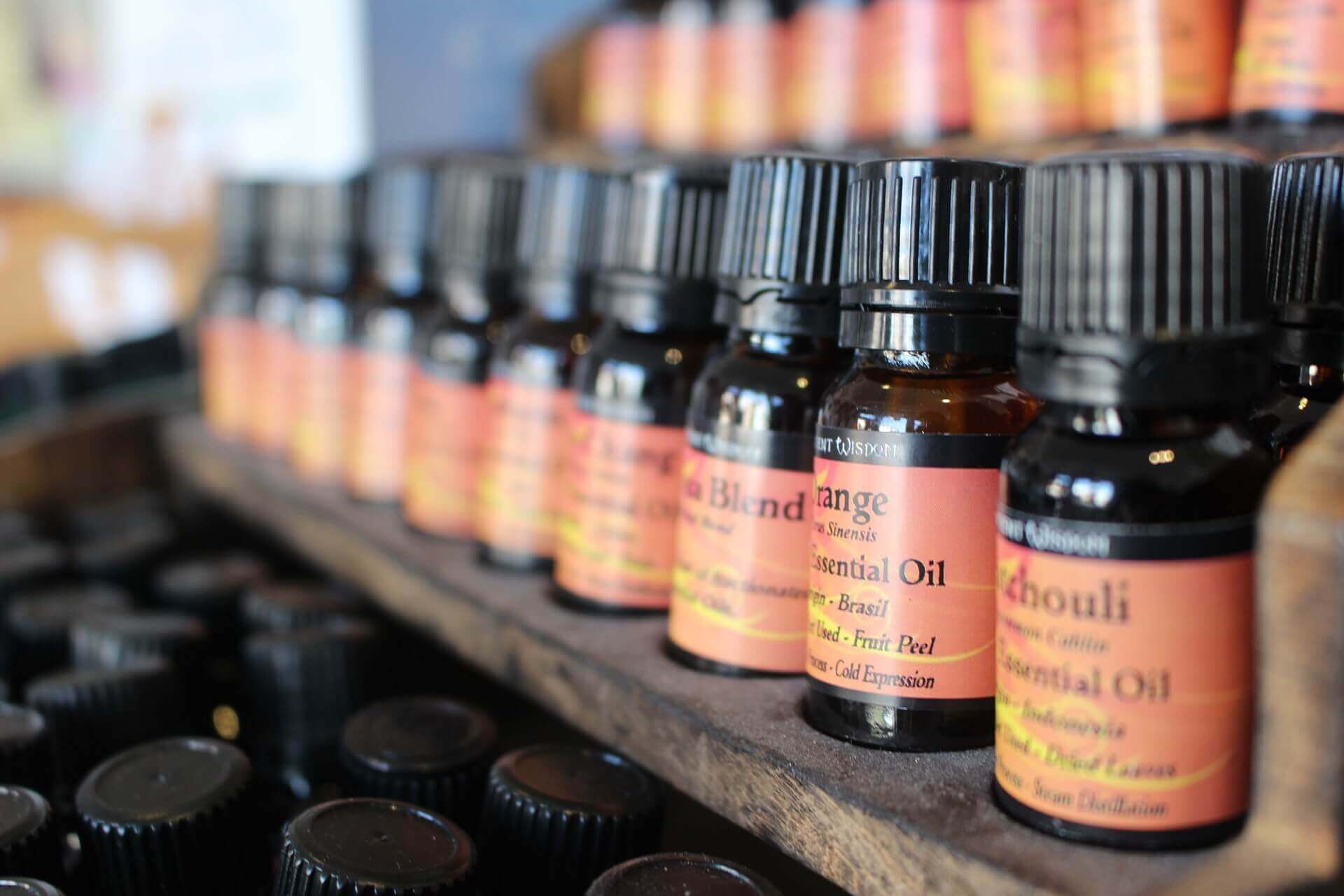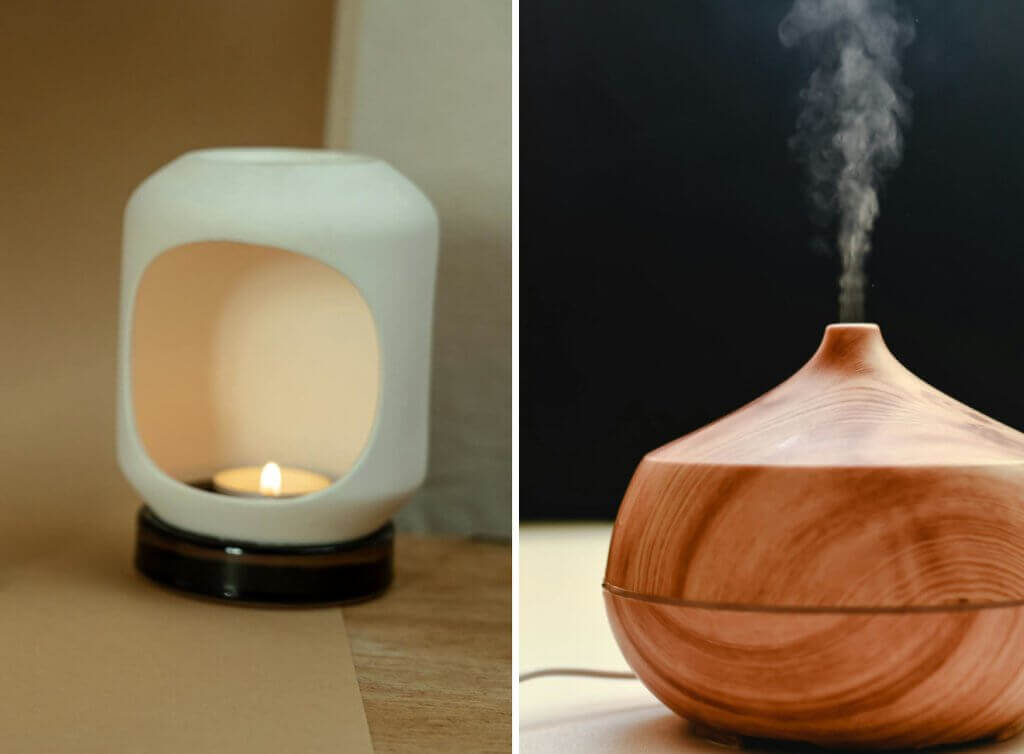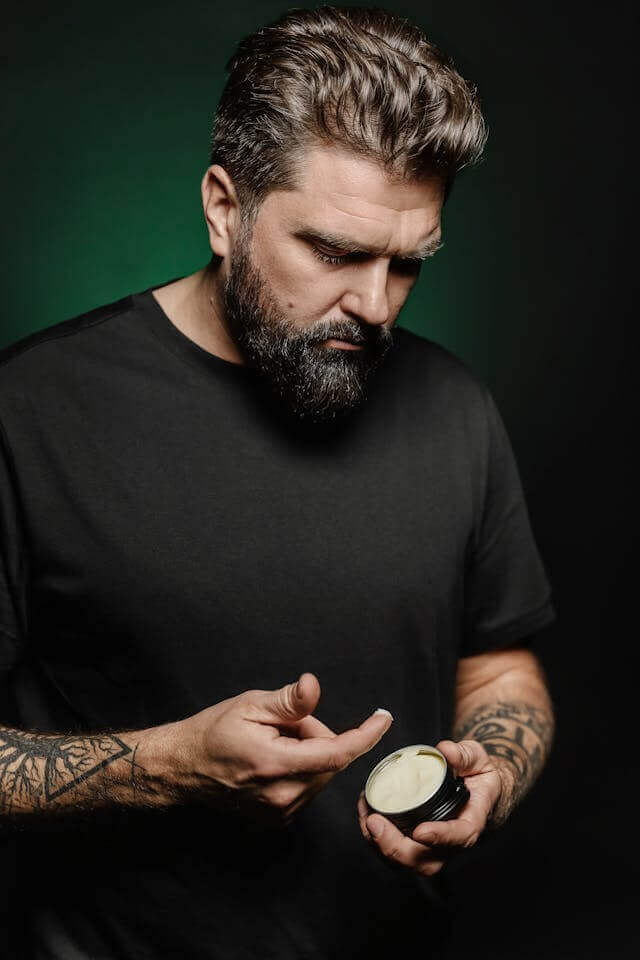
Discover how essential oils can support men’s grooming and well-being, whether it’s stress relief and muscle recovery or beard care and personal hygiene.
Like most men, I had zero interest in essential oils until my ex introduced me to them a few decades ago.
Until then, I thought their only function was to scent the air, but they can do much more than that.
In fact, they’re a real all-rounder. Take a look at the issues I’ve used them for in the past:
- Difficulties relaxing, concentrating, and sleeping
- To stimulate appetite, digestion, and libido
- To help relieve cold symptoms and muscle pain—great after a workout
- To repel insects
- To expel tobacco odors
In many cases, the oils are vaporized in an aromatherapy diffuser; either a classic oil burner with a tealight beneath a bowl, or a more modern electric device.
Or they’re applied directly to the skin with a carrier substance. More on that later.
But first, let’s find out exactly what essential oils are and which are safe for aromatherapy.
About Essential Oils
I enjoy discovering the history and science behind any concept, and that of essential oils is no exception.
What Are Essential Oils?
Essential oils are derived from flowers, fruits, roots, leaves, and bark. Plants produce scent to attract pollinating insects and protect themselves from bacteria and fungal pathogens.
The Origins of Essential Oils
Essential oils have been valued for their therapeutic benefits since Arab traders brought them to the cloisters of Spain and southern France during the twelfth century.
Religious institutions had long understood how incense and aroma could influence mood and atmosphere. The church continued this tradition, implementing oils into worship for spiritual support.
Today they are used similarly in the home to elevate ambience. And they’re a vital component of cosmetics and processed foods to enhance appeal.
“Quality” Essential Oils
Only natural, organic oils extracted by distillation (for herbs and flowers) and cold pressing (for citrus peels) are considered “quality” and “high quality,” the latter being of therapeutic grade.
But some plant oils contain compounds that oxidize rapidly upon extraction, rendering them useless. Their aromas must therefore be synthetically reproduced.
Examples of synthetic oils are apple, apple blossom, lilac, linden, honeysuckle, lotus, magnolia, lily of the valley, almond blossom, passion flower, peach, and violet.
Don’t be fooled by the fact that synthetic oils are included in high-end perfumes; this does not make them “quality” oils.
Because any fragrance can be synthetically manufactured and sold cheaply as “essential oil,” always buy at a pharmacy to ensure that you’re getting a safe, therapeutic product.
Therapeutic Grade Essential Oils—What Makes the Difference?
The most effective oils in aromatherapy are produced from plants grown in regions where climate and soil composition allow them to thrive notably well. Examples include lavender from the Haute Provence of France; orange blossom from Morocco and the coast of Sicily; rose from Bulgaria, Morocco, and Turkey; sandalwood from Mysore; and cedar from Lebanon and the Atlas Mountains.
Therefore, although there is, for instance, such a thing as essential oil of cedar from Virginia, it contains only 40 remedial compounds, whereas cedar oil from the Atlas Mountains contains 160. The latter’s significantly greater therapeutic value earns it the designation of “high quality” or “therapeutic grade.” In contrast, Virginia cedar oil is classified simply as “quality”, its remedial profile being comparatively limited.
How to Benefit from Aromatherapy
Aromatherapy works not only through the sense of smell, but also the skin.
Aromatherapy Through the Sense of Smell
Aroma stimulates the release of neurochemicals that influence mood and frame of mind. The effect can be relaxing, exciting, or seductive—e.g., lemon balm and lavender slow brain activity, affecting relaxation and calm, whereas citrus oils and rosemary have the opposite effect.
As previously mentioned, the best way to apply aromatherapy through the sense of smell is with a “diffuser,” of which there are two main types.
Oil Burners
Oil burners use a tealight to heat a mixture of water and essential oils in a bowl, thus releasing aroma through steam. Depending on the size of the diffuser’s bowl, five to 15 drops of essential oil are usually sufficient.
Never use an oil burner without water, especially as it can cause the bowl to crack depending on its material.
Electric Diffusers
There are various types of electric diffusers. Some use a heating element. Evaporative devices have a fan to diffuse scent. And ultrasonic models double up as humidifiers.
Aromatherapy Through the Skin
The molecules of essential oils are small enough to penetrate the skin and reach underlying tissue, glands, muscles, and organs as well as the circulatory system. Applied through bathing or massage, benefits may be noticeable within minutes.
Just mix five to ten drops of essential oil to your bathwater in a cup of milk—since the oils are hydrophobic, this enables them to disperse in the tub.
For massage, mix three to five drops of oil with a carrier like jojoba or coconut oil. If you have neither of these at hand, honey and fatty foods like heavy cream, sour cream, or mashed avocado are good alternatives.
The safest recommended concentration is 1-2 percent essential oil. More information on dilution is given by the Tisserand Institute—you’ll find a link in the safety note at the end of this post.
Handling and Storing Essential Oils
For maximum benefit and longevity, here are some tips on handling and storing essential oils.
- Because most essential oils can cause irritation, never apply to the skin without diluting with water or adding to a carrier oil or similar. Exceptions are lavender, mint, rose, and lemon balm, but be careful on sensitive skin.
- Store essential oils in dark bottles and keep away from direct sunlight. Never leave bottles open for longer than necessary.
- Pre-mixing oils can shorten their life by up to three months. Therefore, mix massage oils etc. in small quantities only.
- Essential oils last on average about 6 months to a year. They don’t actually “go bad” or turn rancid, but they do oxidize over time, which impairs their therapeutic efficacy. Similar to cologne, an essential oil has expired if it alters its fragrance, turns cloudy, and/or thickens in consistency.
How to Choose Essential Oils
Just as you would when choosing a new cologne, test essential oils first on a strip of blotting paper.
An instant aversion (possibly to the point of nausea) is an indication that the oil will be of no benefit, even if it is recommended for the issue you intend to treat.

Recipes for Aromatherapy Diffusers and Direct Application
In case of an aversion to any of the oils in the following recipes, replace it with one of the listed “alternative oils.”
When applying to the skin with a carrier substance, adjust the given quantities according to the information previously given under the heading Aromatherapy Through the Skin.
And don’t forget to dissperse oils in a cup of milk before adding them to bathwater.
To Create a Relaxing Atmosphere
Vaporized, this recipe is appropriate for the living room or bedroom. Alternatively, add it your to your bathwater or, for an all-over massage, to a carrier oil.
| Oils |
| 6 drops verbena |
| 2 drops lavender |
| or |
| 4 drops grapefruit |
| 1 drop neroli |
| 3 drops cedar |
| Alternative oils: all floral and citrus aromas—e.g., you could replace grapefruit with lemon, or lavender with ylang ylang. |
To Enhance Concentration
Vaporize in your study or work area.
| Oils |
| 3 drops hyssop |
| 4 drops lemon |
| Alternative oils: all citrus oils, mint, rosemary, Arolla pine |
To Relieve Insomnia and Aid Deeper Sleep
Vaporize this recipe in the bedroom or add it to your bathwater.
| Oils |
| 2 drops geranium |
| 3 drops lavender |
| 3 drops lemon balm |
| Alternative oils: Roman chamomile, mimosa, neroli, orange, sandalwood, yarrow, ylang ylang |
Another trick is to apply a few drops of undiluted lavender to the soles of the feet.
To Enhance Libido
Vaporize in the bedroom.
Ylang-ylang is a versatile scent that’s neither masculine nor feminine. But you can swap it with one of the listed alternatives according to appeal.
| Oils |
| 1 drop ylang-ylang |
| 3 drops sandalwood |
| 1 drop vetiver |
| Alternative oils: tuberose (feminine), jasmine (feminine), ambrette seed (masculine) |
To Stimulate Appetite
Vaporize an hour before eating if the situation allows.
| Oils |
| 4 drops grapefruit |
| 3 drops sandalwood |
| 3 drops vetiver |
| Alternative oils: all citrus oils, vanilla, cinnamon |
Muscle Relief After a Workout
Add this recipe to your bathwater, or use it for massage in a carrier oil.
| Oils |
| 3 drops peppermint |
| 3 drops lavender |
| 2 drops of rosemary |
| Alternative oils: eucalyptus, chamomile, cedarwood |
To Relieve Digestive Disorders
Vaporize any one of the following: Roman chamomile, coriander, cumin (jeera), mint, cinnamon
To Relieve Cold Symptoms
Vaporize in the bedroom or add to your bathwater. Mixed with a carrier oil, it also makes an effective chest rub.
| Oils |
| 3 drops eucalyptus |
| 2 drops Arolla pine |
| 5 drops lemon |
| Alternative oils: cajuput, camphor, mountain pine, lavender, hyssop |
To Expel Tobacco Odor
If you’re a man who still enjoys a pipe or cigar in the comfort of his living room, use essential oils to mitigate a lasting odor. Vaporize the following mixture during and after smoking.
| Oils |
| 2 drops myrtle |
| 1 drop neroli |
| 2 drops Arolla pine |
| Alternative oils: bay-leaf, lemon grass, sage, juniper, hyssop, lemon |
To Repel Insects
Vaporize any one of the following: eucalyptus, geranium, lavender, clove, cedar.

Essential Oils in Men’s Grooming
As previously mentioned, essential oils are also used in cosmetics, the most obvious being fragrance products—I’ve dedicated an entire post to making your own cologne.
In addition, here are two more ideas that could be useful.
DIY Underarm Deodorant
Being wary of commercial underarm deodorants, I’ve been using this no-nonsense recipe for a number of years.
Ingredients:
- 1 tbsp cornstarch
- 1 tbsp baking soda
- 1 tsp zinc oxide paste
- 2–4 drops lemon balm essential oil (this is enough to benefit from the antimicrobial and skin-soothing qualities of the oil without it clashing with your cologne)
- ½–1 tsp coconut oil
Instructions:
- Mix main ingredients
Omitting the coconut oil, combine all ingredients in a bowl using a fork. Due to the firm texture, you’ll need to mash it for even blending.
- Add coconut oil
Add coconut oil a little at a time until the texture is smooth.
- Store and use
Scoop into a jar and store in a dark space.
Apply with your fingers or a cosmetic spatula.
Beard and Mustache Oil
For men who value both grooming and wellness, beard oil and balm can do more than condition whiskers; they can deliver the therapeutic benefits of essential oils right under your nose.
For example, my beard balm contains rosemary oil, which helps with concentration during the day.
At night, I switch to a beard and mustache oil with lavender—a clean, manly fragrance that promotes relaxation.
Both of these oils encourage healthy growth.
If you use pure jojoba, coconut, or castor oil, add a drop of beneficial essential oil from the below table.
For commercial products, check their ingredients for an oil that meets your needs.
| Oil | Effects |
| Cedarwood | Antifungal, helps with beardruff, masculine scent |
| Sandalwood | Anti-inflammatory, grounding aroma |
| Vetiver | Earthy, calming |
| Lavender | Soothing, skin-friendly, clean and masculine |
| Geranium | Balancing, skin toning |
| Mint | Cooling, invigorating |
| Rosemary | Fresh, aids concentration |
Essential oils may not be the first thing that comes to mind when thinking about men’s well-being and grooming, but they’ve earned their place in my routine, whether it’s winding down after a long day, sharpening focus during work, or simply smelling good.
Safety Note
Always dilute essential oils before applying them to the skin, and perform a patch test when trying a new oil. Some oils may not be suitable during pregnancy, for children, or for individuals with certain health conditions. If in doubt, consult a medical practitioner before use.
For comprehensive safety guidelines, please refer to the Tisserand Institute’s official safety page.
© 2025 J. Richardson
Related Posts
Disclaimer
The information provided by The Neat and Tidy Man (“we,” “us,” or “our”) on theneatandtidyman.com (the “site”) is for general informational purposes only. While we endeavor to keep the information up to date and correct, we make no representation or warranty of any kind, express or implied, regarding the completeness, accuracy, reliability, suitability, adequacy, validity, or availability of any information on the site. Under no circumstance shall we have any liability to you for any loss or damage of any kind incurred as a result of the use of the site or reliance on any information provided on the site. Your use of the site and your reliance on any information on the site is solely at your own risk.



